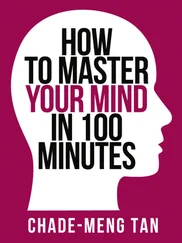Tan, Chade-Meng - Search Inside Yourself - The Unexpected Path to Achieving Success, Happiness (and World Peace)
Здесь есть возможность читать онлайн «Tan, Chade-Meng - Search Inside Yourself - The Unexpected Path to Achieving Success, Happiness (and World Peace)» — ознакомительный отрывок электронной книги совершенно бесплатно, а после прочтения отрывка купить полную версию. В некоторых случаях можно слушать аудио, скачать через торрент в формате fb2 и присутствует краткое содержание. Год выпуска: 2012, Издательство: Harper Collins, Inc., Жанр: Старинная литература, на английском языке. Описание произведения, (предисловие) а так же отзывы посетителей доступны на портале библиотеки ЛибКат.
- Название:Search Inside Yourself: The Unexpected Path to Achieving Success, Happiness (and World Peace)
- Автор:
- Издательство:Harper Collins, Inc.
- Жанр:
- Год:2012
- ISBN:нет данных
- Рейтинг книги:4 / 5. Голосов: 1
-
Избранное:Добавить в избранное
- Отзывы:
-
Ваша оценка:
- 80
- 1
- 2
- 3
- 4
- 5
Search Inside Yourself: The Unexpected Path to Achieving Success, Happiness (and World Peace): краткое содержание, описание и аннотация
Предлагаем к чтению аннотацию, описание, краткое содержание или предисловие (зависит от того, что написал сам автор книги «Search Inside Yourself: The Unexpected Path to Achieving Success, Happiness (and World Peace)»). Если вы не нашли необходимую информацию о книге — напишите в комментариях, мы постараемся отыскать её.
Search Inside Yourself: The Unexpected Path to Achieving Success, Happiness (and World Peace) — читать онлайн ознакомительный отрывок
Ниже представлен текст книги, разбитый по страницам. Система сохранения места последней прочитанной страницы, позволяет с удобством читать онлайн бесплатно книгу «Search Inside Yourself: The Unexpected Path to Achieving Success, Happiness (and World Peace)», без необходимости каждый раз заново искать на чём Вы остановились. Поставьте закладку, и сможете в любой момент перейти на страницу, на которой закончили чтение.
Интервал:
Закладка:
“Yes, you have a case of happiness. The good news is that I can cure it straightaway.”
Truth be told, of the three good things enabled by emotional intelligence, happiness is the one I really care about. (Hush hush, but just between you and me and the million other people reading this book, the other points about stellar work performance and outstanding leadership, while useful and true and supported by scientific evidence, are used by me mostly to get a stamp of approval from upper management.) What I really care about is happiness for my co-workers. That is why emotional intelligence excites me. It doesn’t just create the conditions for stellar success at work; it also creates the conditions for personal happiness for everyone. And I like happiness.
Optimize Thyself
If there is a one-word summary of everything I just said (hint: there is), that word is optimize . The aim of developing emotional intelligence is to help you optimize yourself and function at an even higher level than what you are already capable of. Even if you are already outstanding at what you do (which everybody in our class at Google is), sharpening and deepening your emotional competencies can give you an extra edge. We hope the training in these pages can help you go from good to great.
Cultivating Emotional Intelligence
When people come to a course such as ours that advertises itself as an “emotional intelligence course,” most people expect it to be a purely behavioral course. They expect to be told how to play nice, share candy, and not bite their co-workers.
We decided on an entirely different approach, focusing primarily on expanding the range and depth of people’s emotional abilities. We begin with the insight that emotional intelligence is a collection of emotional skills and, like all skills, emotional skills are trainable. We created a course to train those skills. We feel that if we develop skills, behavioral issues automatically go away. For example, if a person acquires the ability to skillfully manage his own anger, then all his behavioral issues involving anger are “automagically” solved. Emotional skillfulness frees us from emotional compulsion. We create problems when we are compelled by emotions to act one way or another, but if we become so skillful with our emotions that we are no longer compelled, we can act in rational ways that are best for ourselves and everybody else. And we will play nice, share candy, and not bite our co-workers.
Emotional intelligence is trainable, even in adults. This claim is based on a fairly new branch of science known as “neuroplasticity.” The idea is that what we think, do, and pay attention to changes the structure and function of our brains. A very interesting example of this comes from drivers of traditional black cabs in London. To get a license to drive that cab, you need to navigate the twenty-five thousand streets of London and all its points of interest in your head. This is a difficult test that can take two to four years of intense training to prepare for. Research has shown that the part of the brain associated with memory and spatial navigation, the hippocampus, is bigger and more active in London cabbies than in the average person. More interestingly, the longer someone has been driving a cab in London, the larger and more active her hippocampus. 9
One very important implication of neuroplasticity is that we can intentionally change our brains with training. For example, research by my friend and fellow Search Inside Yourself teacher Philippe Goldin shows that after just sixteen sessions of cognitive-behavioral therapy (CBT), people with social anxiety disorder are able to increase activity in the parts of their brains associated with self-regulation, linguistic processing, and attention when working with their own negative self-beliefs. 10Think about it, if we can train our brains to overcome even serious emotional disorders, just imagine the possibility of using it to greatly improve the quality of our emotional lives. That is the promise of the science and practices described in these pages.
A fascinating example of the application of neuroplasticity comes from the work led by Christopher deCharms. 11DeCharms had people who suffer from chronic pain lie inside a magnetic resonance imaging (MRI) scanner and, using real-time functional magnetic resonance imaging (rtfMRI) technology, he showed each participant an image of a fire on a video screen. The greater the neural activity in the parts of their brains associated with their pain, the greater the fire became. By using that visual display, he could get people to learn to up- or down-regulate that brain activity and, with that ability, participants reported a corresponding decrease in their levels of pain. He calls this “neuroimaging therapy.”
Brain. Trainable. Good.

Train Attention
How do we begin training emotional intelligence? We begin by training attention.This may seem a little counterintuitive at first. I mean, what does attention have to do with emotional skills?
The answer is that a strong, stable, and perceptive attention that affords you calmness and clarity is the foundation upon which emotional intelligence is built. For example, self-awareness depends on being able to see ourselves objectively, and that requires the ability to examine our thoughts and emotions from a third-person perspective, not getting swept up in the emotion, not identifying with it, but just seeing it clearly and objectively. This requires a stable and clear, non-judging attention. Another example shows how attention relates to self-regulation. There is an ability called “response flexibility,” which is a fancy name for the ability to pause before you act. You experience a strong emotional stimulus, but instead of reacting immediately as you normally would (for example, giving the other driver the bird), you pause for a split second, and that pause gives you choice in how you want to react in that emotional situation (for example, choosing not to give the other driver the bird, which may save you a lot of trouble because the other driver may be an angry old man with golf clubs who turns out to be the father of the woman you’re dating). That ability depends again on having a quality of attention that is clear and unwavering.
To quote Viktor Frankl, “Between stimulus and response, there is a space. In that space lies our freedom and our power to choose our response. In our response lies our growth and our happiness.” What a mind of calmness and clarity does is to increase that space for us.
The way to train this quality of attention is something known as “mindfulness meditation.” Mindfulness is defined by Jon Kabat-Zinn as “paying attention in a particular way: on purpose, in the present moment, and non-judgmentally.” 12The famous Vietnamese Zen master Thich Nhat Hanh defined mindfulness very poetically as “keeping one’s consciousness alive to the present reality,” 13which I really like, but I found Jon’s definition easier to explain to the engineers, and I like the engineers. Mindfulness is a quality of mind that we all experience and enjoy from time to time, but it is something that can be greatly strengthened with practice, and once it becomes sufficiently strong, it leads directly to the attentional calmness and clarity that forms the basis of emotional intelligence.
There is scientific evidence showing that improving our ability to regulate our attention can significantly impact how we respond to emotions. An interesting study by neuroimaging researcher Julie Brefczynski-Lewis and colleagues revealed that when expert meditators (those with ten thousand or more hours of meditation training) were subjected to negative sounds (for example, a woman screaming), they showed lesser activation in the part of the emotional brain called the amygdala compared to novice meditators. 14Furthermore, the more hours of meditation training the expert had, the lower the activation in the amygdala. This is fascinating because the amygdala has a privileged position in the brain—it is our brain’s sentinel, constantly scanning everything we see for threats to our survival.
Читать дальшеИнтервал:
Закладка:
Похожие книги на «Search Inside Yourself: The Unexpected Path to Achieving Success, Happiness (and World Peace)»
Представляем Вашему вниманию похожие книги на «Search Inside Yourself: The Unexpected Path to Achieving Success, Happiness (and World Peace)» списком для выбора. Мы отобрали схожую по названию и смыслу литературу в надежде предоставить читателям больше вариантов отыскать новые, интересные, ещё непрочитанные произведения.
Обсуждение, отзывы о книге «Search Inside Yourself: The Unexpected Path to Achieving Success, Happiness (and World Peace)» и просто собственные мнения читателей. Оставьте ваши комментарии, напишите, что Вы думаете о произведении, его смысле или главных героях. Укажите что конкретно понравилось, а что нет, и почему Вы так считаете.







![Chade-Meng Tan - Search Inside Yourself - Increase Productivity, Creativity and Happiness [ePub edition]](/books/703803/chade-thumb.webp)



